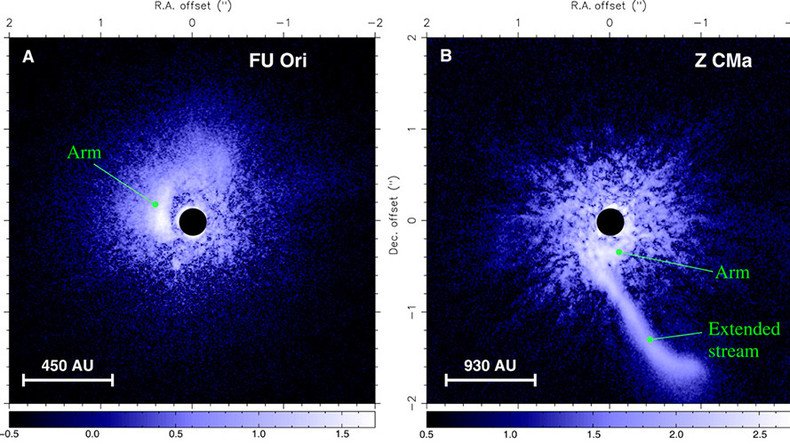‘Sudden feedings’: Young stars undergo turbulent, violent phases

A new study suggests that stars undergo violent “feeding” periods on their way towards celestial maturity. The discovery competes with previous theories that stars underwent stable growth.
An international group of astronomers from Taiwan, Japan and the US used the Subaru Telescope’s near-infrared capabilities in Mauna Kea, Hawaii, to examine the development history of four young stars, including the FU Orionis in the constellation of Orion.
Stars Form in Turbulent Times: So Hauyu Baobab Liu (Academia Sinica Institute of Astronomy and Astrophysics, T... https://t.co/CXbC70is2l
— Astronomy Tweets (@starsmaven) February 6, 2016
A major topic in astrophysics concerns what causes a star to grow in mass. Scientists know that stars are born inside a rotating cloud of interstellar gas and dust. They also know that before the star is officially born, the cloud of gas and dust lands on a circumstellar disk forming around the star due to angular momentum. What was missing was how all this material on the disk was transferred to the star.
What researchers found is that the stars may not accumulate their final mass steadily, but rather in “a series of violent events manifesting themselves as sharp stellar brightening.”
"The bursts of young stars requires sudden feedings with large amount of masses," Hauyu Baobab Liu, a co-author of the study, told Mashable. "We... believe that the most natural mechanism to explain such feeding, is gravitational instability."
Baby stars may grow in violent fits and starts:
— thetweetking (@thetweetkings) February 5, 2016
Young stars may grow through violent binges on raw cosmic mat... https://t.co/iNmuzQun7V
In the case of the FU Orionis star, astronomers saw an increase in brightness by a factor of 250 over a time period of just one year, and then remaining in a high-luminosity state for almost 100 years.
The study used hydrodynamic simulations and radiative transfer models to show the violent bursts, and astronomers said they can be explained by strong gravitational instabilities occurring at the beginning of the disk formation phase. However, the effect of those bursts of growth in the evolution of a star or planet remains to be understood.
Astronomer Jonathan Tan, who wasn’t involved in the study, told Mashable that theoretical modeling of star systems is a very complicated business.
"Their work involves sophisticated simulations that follow the flows of gas and the effects of gravity," Tan said. "They also simulate how radiation will interact with the structures in their simulations. However, they do not appear to include the effects of magnetic fields, so there is more work to be done to be sure that this missing physics is not influencing the results of the simulations."
Violent, head-to-head crash between Earth and another planet created the moon https://t.co/GHwz0vTYrCpic.twitter.com/81Vhj3DbiD
— RT America (@RT_America) January 30, 2016
The idea of space material clumping onto a star was argued 10 years ago by astrophysicist Eduard Vorobyov, who is now working at the Astrophysical Department of Vienna University. He theorized that star brightening can be caused by “fragmentation due to gravitational instabilities in massive gaseous disks surrounding young stars, followed by migration of dense gaseous clumps onto the stars.”
"This is a major step towards our understanding of how stars and planets form and evolve", Vorobyov said in a statement about the new study. "If we can prove that most stars undergo such episodes of brightening caused by disk gravitational instability, this would mean that our own Sun might have experienced several such episodes, implying that the giant planets of the Solar system may in fact be lucky survivors of the Sun's tempestuous past."
Edgar Mitchell, who walked on the moon and believed in aliens, dead at 85https://t.co/EstsVLdtmzpic.twitter.com/0SFSPbUnTz
— RT America (@RT_America) February 6, 2016
The study, titled “Circumstellar disks of the most vigorously accreting young stars,” was published in the Friday edition of Science Advances.











